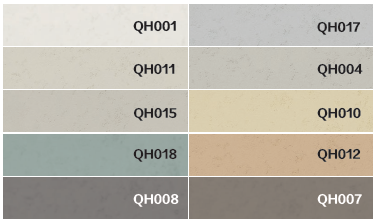
Art paint and coatings with a Crystal Ice Stone effect are based on exterior textured finishes. They feature high hardness, excellent washability, and mold resistance. The application process is convenient, primarily through roller coating. The finish resembles that of micro-cement but offers a higher cost-performance ratio.

I. Technical Principles and Product Characteristics
1. Core Ingredients and Technology
- Main Components: Crystalline ice-effect art paint primarily consists of high-quality emulsion, natural or sintered colored sand, additives, and water. The natural or sintered colored sand is a key ingredient that gives the paint its unique texture and color.
- Role of Emulsion: The emulsion serves as the film-forming substance in the art paint, determining the hardness, flexibility, weather resistance, and adhesion of the paint film. High-quality emulsion enables the paint film to have excellent water resistance, mildew resistance, and UV resistance.
- Sintered Colored Sand Technology: Sintered colored sand is produced through a high-temperature sintering process, which gives it stable color, high hardness, and strong wear resistance. This type of sand creates a natural stone-like texture in the paint, while avoiding the high costs and complex installation associated with natural stone.
2. Achieving Unique Texture
- Icy Crystal Effect: Through special formulations and processes, crystalline ice-effect art paint can create a transparent or semi-transparent icy crystal texture on the surface. This effect is typically achieved by adding special transparent particles or using unique spraying techniques.
- Textured Effects: Crystalline ice-effect art paint can achieve a variety of textured effects through different application methods, such as spraying, troweling, and rolling. These textured effects not only add three-dimensionality to the wall but also enhance the decorative layering.
3. Environmental Performance
- Water-based Formulation: Crystalline ice-effect art paint uses a water-based, environmentally friendly formula with water as the solvent. It is odorless and has extremely low VOC (volatile organic compound) emissions, meeting international environmental standards.
- Free from Harmful Substances: The product contains no harmful chemicals, such as formaldehyde, benzene, or heavy metals, making it safe for human health and the environment. It is especially suitable for places with high environmental requirements, such as homes, schools, and hospitals.
II. Application Techniques and Processes
1. Preparation Before Application
- Surface Preparation: The wall must be flat, dry, clean, and free from oil, dust, and loose material. If the wall has old coatings, they need to be sanded or removed first.
- Primer Application: A dedicated sealing primer must be applied before the art paint. The primer’s role is to seal the pores in the wall, preventing moisture penetration and enhancing the adhesion of the art paint.
2. Application Methods
- Spraying: Spraying is the most commonly used method for crystalline ice-effect art paint. Using professional spraying equipment, the paint is evenly sprayed onto the wall. During spraying, attention should be paid to the distance, angle, and speed of the spray gun to ensure the uniformity of the textured effect.
- Troweling: For walls that require special textured effects, troweling can be used. The paint is evenly applied to the wall with a trowel, and then textures are created through scraping and smoothing techniques.
- Rolling: Rolling is suitable for large-area applications. The paint is evenly rolled onto the wall with a roller. This method is highly efficient in application, but the textured effect is relatively simple.
3. Texturing
- Texturing Tools: During the application process, various texturing tools (such as sponges, rollers, trowels, etc.) can be used to create different textured effects. For example, gently patting the wall with a sponge can create an icy crystal texture, while scraping with a trowel can create a sandstone texture.
- Multi-layer Application: To achieve a better decorative effect, multiple layers of application are usually required. The first layer is mainly for the base, forming the basic texture, while subsequent layers enhance the textural effect and color saturation.
4. Drying and Curing
- Drying Time: The drying time of crystalline ice-effect art paint generally depends on the ambient temperature and humidity. Typically, the surface drying time is 2-4 hours, and the complete drying time is 24 hours.
- Curing Time: Full curing takes about 7 days. During this period, the wall should be protected from collisions or friction.
III. Performance Features
1. Durability
- Weather Resistance: Crystalline ice-effect art paint has excellent weather resistance, capable of withstanding the effects of UV radiation, wind, rain, and temperature changes, with a service life of up to 15-20 years.
- Wear Resistance: Due to its high hardness, the paint can effectively resist scratches and wear from daily use, making it suitable for places with frequent human activity, such as homes, hotels, and shopping malls.
2. Protective Properties
- Waterproof and Mildew-Resistant: The paint film of crystalline ice-effect art paint has good waterproof properties, effectively preventing moisture penetration, and also has mildew-resistant functions, making it suitable for use in humid environments.
- UV Resistance: The product contains UV absorbers, which can effectively prevent wall fading and aging.
3. Decorative Effects
- Rich Colors: Crystalline ice-effect art paint can be custom-colored to meet customer needs, with stable and lasting colors.
- Unique Texture: Its icy crystal texture and sandstone patterns can add a unique artistic effect to the wall, enhancing the overall decorative quality.
IV. Application Scenarios
1. Interior Decoration
- Living Rooms and Bedrooms: The elegant and fresh visual effects of crystalline ice-effect art paint’s icy crystal texture and delicate patterns make it ideal for living rooms and bedrooms, especially for those who pursue personalization and artistic appeal in their living spaces.
- Children’s Rooms: Due to its high environmental performance and odorless nature, it is very suitable for children’s rooms. Additionally, its strong washability allows for easy cleaning of wall stains.
- Commercial Spaces: In commercial spaces such as hotel lobbies, restaurants, and exhibition halls, crystalline ice-effect art paint can create a luxurious and sophisticated atmosphere, enhancing the overall quality of the space.
2. Exterior Decoration
- Exterior Wall Decoration: The weather resistance and protective properties of crystalline ice-effect art paint make it an ideal material for exterior wall decoration. It can effectively protect buildings from wind and rain erosion while adding artistic beauty to the exterior appearance.
- Old Wall Renovation: For the exterior renovation of old buildings, crystalline ice-effect art paint can be directly applied over the old coating without the need for removal, significantly saving construction time and costs.
V. Maintenance and Care
1. Daily Cleaning
- Stain Removal: The walls coated with crystalline ice-effect art paint have good washability. Daily stains can be gently wiped with a damp cloth. For stubborn stains, a neutral cleaner can be used for cleaning.
- Precautions: Avoid using hard objects or rough cleaning tools to scrub the wall to prevent damage to the paint film.
2. Long-term Maintenance
- Avoiding Impact: Although the paint has high hardness, the wall should still be protected from collisions with hard objects.
- Regular Inspection: Regularly inspect the wall for peeling, cracking, or other issues, and address any problems promptly with repairs.
VI. Summary
Crystalline ice-effect art paint and coatings are highly favored in modern architectural decoration due to their unique icy crystal texture, rich color options, excellent environmental performance, and durability. Whether used in indoor living spaces or exterior building walls, their unique decorative effects can enhance the overall aesthetic and quality of the space. Moreover, their easy application and simple maintenance make them highly cost-effective in practical use.
